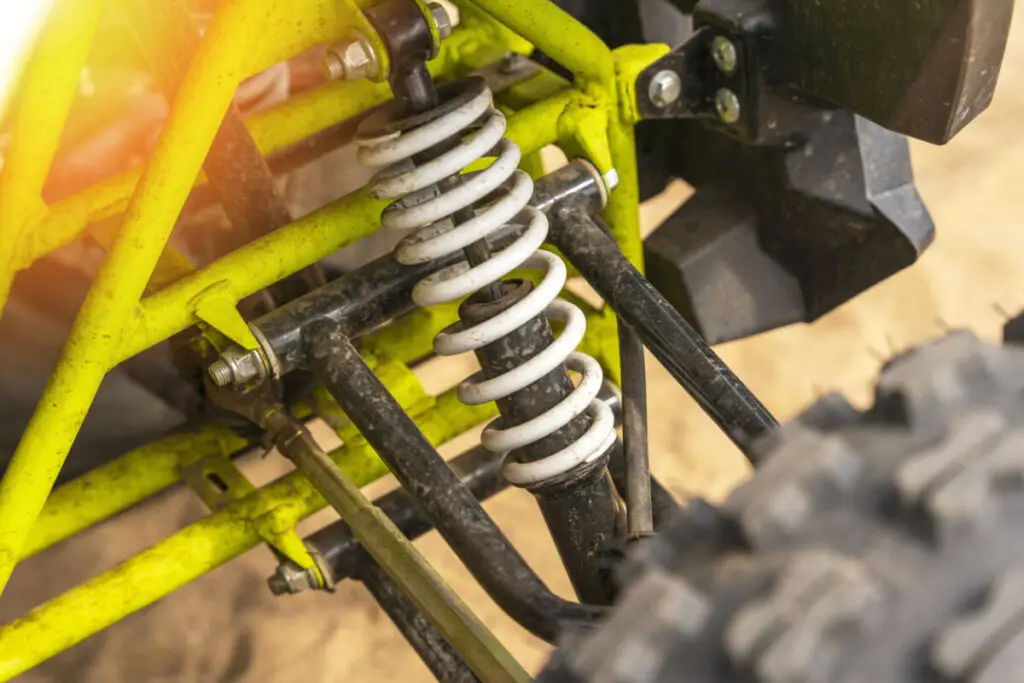
ATV shocks are an essential part of every ATV as they play a huge role in both comfort and safety. Every once in a while you may realize the terrain you ride on is too tough or the riding you are doing is too intense. While most default shock settings will be fine for casual riding, depending on your terrain or riding style adjusting them may benefit you greatly.
For most ATVs adjusting the shocks will use a small adjuster knob. The knob will be under the piston of the shock and you will simply take some vice grips, hold tightly and twist until you find your preferred setting. On some newer ATV and UTV models this may be unnecessary as there may be an automatic suspension system where you just push a button to rise or lower the suspension.
This process can vary depending on the model or the design of the vehicle. Why you might want to adjust the shocks, what ATV shocks do and what adjusting them will do to your ATV experience are all important topics that will be discussed in this article.
ATV Shocks in Detail
ATV shocks will affect your ride tremendously which is why adjusting them to the right setting is very important. To really dig down into why adjusting your ATV shocks is important and what to adjust them to we have to look at the anatomy of the shocks themselves. How do shocks work?
Shocks are made up of two main parts the spring and the dampener. The two work in harmony to create a smooth and safe ride but what do each do? The spring’s job is to compress when the ATV hits a bump or some other obstacle. The spring’s tension will then drop the tire down again which will allow it to regain traction. The problem here is, if we just have a spring then the ATV will be bouncing everywhere like it’s on a trampoline. This is where the dampener comes in. The dampener will somewhat counter the spring by absorbing its force. It absorbs as much of the force as it can and the reaction the vehicle has to the bump is as minimized as possible.
This is all useful and interesting but how does it play a role in adjusting your shocks? When you adjust the shock you aren’t just making it higher off the ground. You are actually bringing that dampener up closer or further from the spring to create more or less compression in the spring. If you are adjusting the shocks higher the spring will compress less and create a stiffer spring with less give. This means you’ll feel more bumps and the ATV will feel like it is driving on a bumpy surface. If you adjust the shocks lower it will give the ATV more compression and create a bouncier ride. Both sound bad but it is more about how you adjust it, which relates directly to the terrain and driving style of the rider. If you are adjusting your shocks, I suggest you play around with it and find what feels the most comfortable for you.
When adjusting the shock grab some vice grips, hold that small adjustment knob and twist. Once you find your preferred setting just let go and the rest will be history.
Most will look similar to this but different models and brands will vary tremendously. To adjust a clicker like this you would simply take off the clicker and manually adjust the shocks to whatever height you desire. If your shocks are different or you think you have messed something up, there are dozens of helpful YouTube videos on the internet that probably relate to your exact problem.
ATVs With an Automatic Suspension Adjustment
Although it is rare and often only in newer ATV models, some will simply require the push of a button to adjust the suspension. With these automatic adjusters it is important to remember not to manually adjust them and to just use the button because if it ain’t broke don’t fix it. If the button isn’t working for whatever reason then you should probably consult a mechanic.
The Importance of Adjusting Shocks
Shocks are a necessary part of an ATV; a common misconception though is that shocks are designated for comfort and comfort only. This is not true. Safety in an ATV is crucial because at the end of the day the vehicles can be dangerous. If you are riding on an extremely bumpy trail or riding very aggressively then adjust your shocks accordingly. The last thing you want is to get a concussion or any other kind of injury from hitting an abnormally large bump.
Installing New Shocks
Installing new shocks can be a bit of a headache. Fitting it all into this one little paragraph would be a little hard so we wrote an article on it. Below is a tutorial guide on how to install new shocks:

